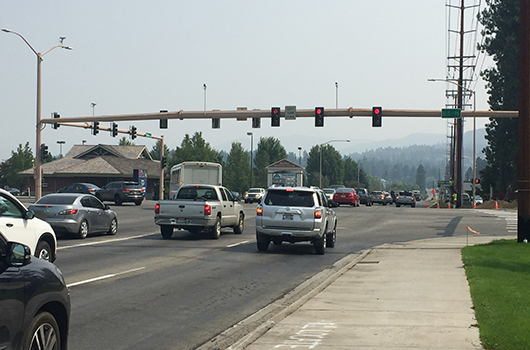This summer 11 signals on U.S. Highway 95 in Coeur d’Alene and Hayden will be upgraded, with work set to start tonight.
Construction will occur Sunday night through Thursday night between 8 p.m./9 p.m. and 5 a.m. Weekend work is possible and will generally start later at night to minimize impacts.
The project will focus on one intersection at a time, with work scheduled to take about one week per intersection. The contractor will start upgrades tonight at the signals for the I-90 ramps and generally move north throughout the summer to the signal at Lancaster Road.
As each intersection receives repairs at night, the signal will be shut off, and the highway will be reduced to one lane. Traffic on all intersecting roadways will be controlled by flaggers, but by 5 a.m. the signal will be functioning normally.
Some intersections will experience more significant impacts. Construction will affect the below intersections both night and day. Traffic already on US-95 will not be able to turn left off the highway, and traffic on the side street will only be able to turn right onto the highway. Drivers needing to turn left off US-95 can follow posted detours or make a U-turn at the next intersection.
- Neider Avenue in late June
- Dalton Avenue in late June
- Hanley Avenue in mid-July
- Honeysuckle Avenue in late July
- Hayden Avenue in early August
- Wyoming Avenue in mid-August
- Lancaster Road in late August
Upgrades include many safety features, like pre-emption devices that will allow emergency services providers to trigger green lights when responding to calls or backup power that will ensure signals at the busiest intersections will stay lit during long outages.
“Over the last several years, we have seen extended power outages,” Project Manager Breanna Logerwell said. “When our signals lose power, they eventually go into flash mode, or each direction gets a flashing red or yellow light to stop or to yield. Some of these intersections see almost 60,000 vehicles a day, so that kind of stop-and-go situation creates significant congestion and can be a major safety concern if drivers don’t realize they’re not operating like normal.”
Many of the signals on US-95 have been in place more than 30 years, and the systems that detect traffic and send information to the signals have largely not been updated since before 2010.
“For those drivers who feel like the signal rotation skips them, this will solve that,” Logerwell said. “We’ll have the latest technology to detect traffic and optimize overall flow in the corridor.”
The project is expected to take about four months. A specialized consultant has been hired to develop a new timing plan for the signals after the upgrades are complete.
For live traffic impacts and to know the timing of construction at each intersection, visit 511.idaho.gov.

